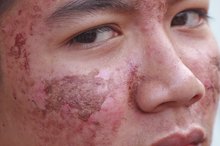Cysts Near the Groin Area in a Child
Encountering a lump anywhere on your child's body can be frightening. Do not panic if you find a lump in your child's groin area 4. Arm yourself with the necessary information to address the concern before allowing worry to set in.
If you are experiencing serious medical symptoms, seek emergency treatment immediately.
Cysts
A cyst is a broad term that refers to a lump in the body that develops somewhere it should not. Cysts are filled with fluid and can occur anywhere on your child's body. Often they are benign, or noncancerous. A cyst in your child's groin area may not actually be a cyst 4. The lump you are feeling could be one of many different things.
- A cyst is a broad term that refers to a lump in the body that develops somewhere it should not.
- Cysts are filled with fluid and can occur anywhere on your child's body.
Hernia
Hard Bumps on a Child's Skin
Learn More
The cyst you are feeling in your child's groin area could be a hernia 34. A hernia is when a weak area or even a tear in the muscle in your child's groin area allows an organ or other tissue to bulge out 4. A hernia can poke through a normal area that will eventually close up as your child grows or can be the result of injury or strain. You may notice the hernia as a small lump. An inguinal hernia is a hernia that can occur in the groin area of a child, and is seen more often in boys than girls 4. Often this type of hernia is a portion of your child's intestine protruding. Surgery will be required to repair an inguinal hernia.
Lymph Nodes
If you feel a lump in your child's groin area, it may not be a cyst at all 4. It could simply be a normal pediatric lymph node. If what you are feeling is a row of lumps, it is likely you have encountered lymph nodes in the groin area. A typical lymph node will feel soft to the touch and will move around underneath your child's skin when you touch it. These lumps will be about the size of a pea. However, if your child has an infection, such as a cold or virus, the size of the lymph nodes in the groin area or anywhere on the body may be larger 4.
Treatment
How to Strengthen the Abdominal Muscles After an Inguinal Hernia Operation
Learn More
Regardless of how big or small the lump you have encountered is, your best bet is to have your doctor examine it. If the lump is hard and immovable or if touching it causes your child pain, it is a bit more urgent that your doctor see it. Most cysts are not cancerous or life-threatening; however, only a trained medical professional can determine exactly the cause of any lump.
- Regardless of how big or small the lump you have encountered is, your best bet is to have your doctor examine it.
Related Articles
References
- MedlinePlus: Cyst
- MayoClinic.com: Tumor vs. Cyst: What's the Difference?
- KidsHealth: Could that Lump be a Hernia?
- BabyZone: Knot in My Child's Groin Area
- American Academy of Orthopedic Surgeons. (n.d.). Hip Fractures. https://orthoinfo.aaos.org/en/diseases--conditions/hip-fractures/
- Shetty VD, Shetty NS, Shetty AP. Groin pain in athletes: a novel diagnostic approach. SICOT J. 2015;1:16. doi:10.1051/sicotj/2015017
- Tyler TF, Silvers HJ, Gerhardt MB, Nicholas SJ. Groin injuries in sports medicine. Sports Health. 2010;2(3):231-6. doi:10.1177/1941738110366820
- Jenkins JT, O'dwyer PJ. Inguinal hernias. BMJ. 2008;336(7638):269-72. doi:10.1136/bmj.39450.428275.AD
- Chung C, Stern PJ, Dufton J. Urolithiasis presenting as right flank pain: a case report. J Can Chiropr Assoc. 2013;57(1):69-75.
- Khan AM, Mcloughlin E, Giannakas K, Hutchinson C, Andrew JG. Hip osteoarthritis: where is the pain? Ann R Coll Surg Engl. 2004;86(2):119-21. doi:10.1308/003588404322827518
- Pun S, Kumar D, Lane NE. Femoroacetabular impingement. Arthritis Rheumatol. 2015;67(1):17-27. doi:10.1002/art.38887
- Groh MM, Herrera J. A comprehensive review of hip labral tears. Curr Rev Musculoskelet Med. 2009;2(2):105-17. doi:10.1007/s12178-009-9052-9
- Moya-angeler J, Gianakos AL, Villa JC, Ni A, Lane JM. Current concepts on osteonecrosis of the femoral head.World J Orthop. 2015;6(8):590-601. doi:10.5312/wjo.v6.i8.590
- Larson CM. Sports hernia/athletic pubalgia: evaluation and management. Sports Health. 2014;6(2):139-44. doi:10.1177/1941738114523557
- Allegri M, Montella S, Salici F, et al. Mechanisms of low back pain: a guide for diagnosis and therapy. F1000Res. 2016;5. doi:10.12688/f1000research.8105.2
- Gomella P, Mufarrij P. Osteitis pubis: A rare cause of suprapubic pain. Rev Urol. 2017;19(3):156-163.
- Bisciotti GN, Auci A, Di marzo F, et al. Groin pain syndrome: an association of different pathologies and a case presentation. Muscles Ligaments Tendons J. 2015;5(3):214-22. doi:10.11138/mltj/2015.5.3.214
- American Academy of Orthopedic Surgeons. (n.d.). Hip Fractures.
- Bisciotti GN et al. Groin Pain Syndrome: An Association of Different Pathologies and a Case Presentation. Muscles Ligaments Tendons J. 2015 Jul-Sep;5(3):214-22.
- Johnson R. (2018). Approach to hip and groin pain in the athlete and active adult. Fricker P, Fields KB, eds. UpToDate. Waltham, MA: UpToDate Inc.
- Martin RR, Martin HD, Kivlan BR. Nerve Entrapment in the Hip Region: Current Concepts Review. Int J Sports Phys Ther. 2017 Dec;12(7):1163-73.
- Wilson JJ, Furukawa M. Evaluation of the Patient with Hip Pain. Am Fam Physician. 2014 Jan 1;89(1):27-34.
Writer Bio
Based in Wisconsin farm country, Jami Kastner has been writing professionally since 2009 and has had many articles published online. Kastner uses her experience as a former teacher, coach and fitness instructor as a starting point for her writing. She has a Bachelor of Arts degree in secondary education from Trinity International University.








